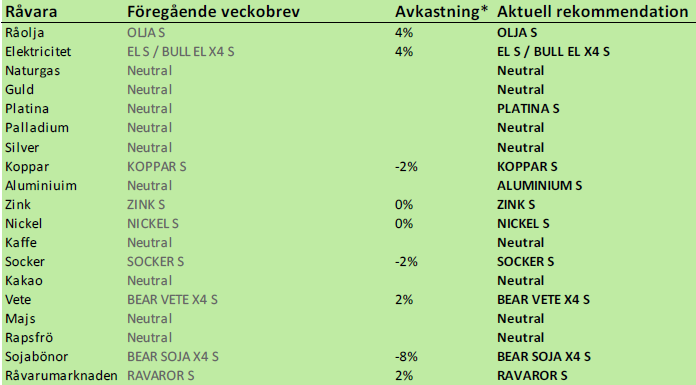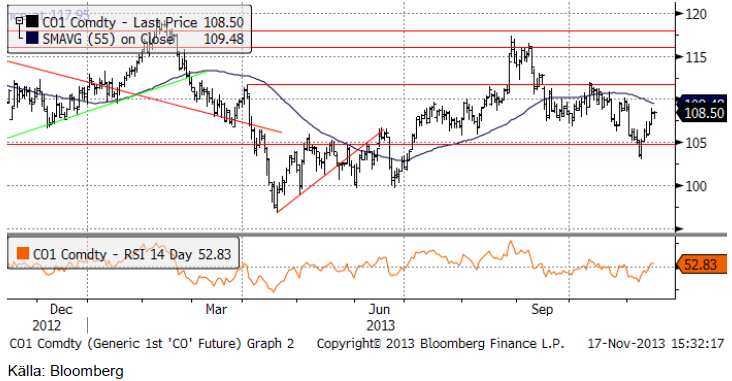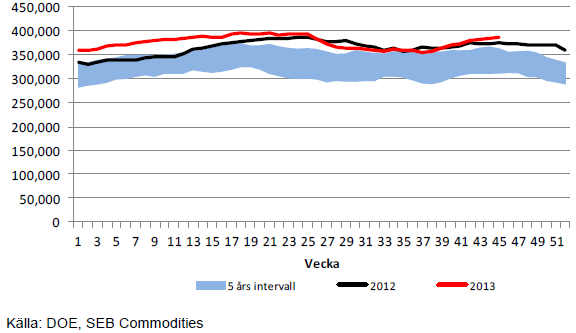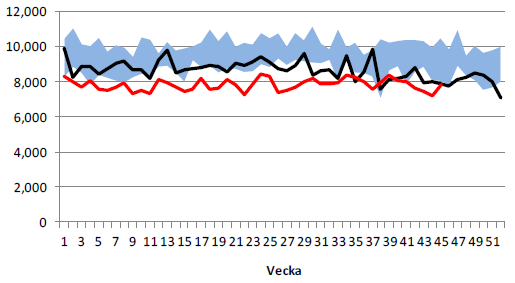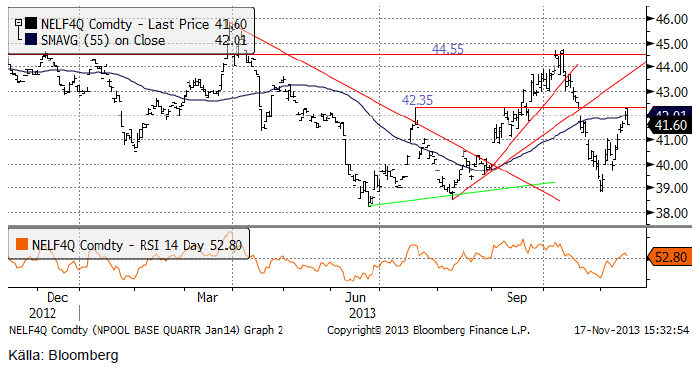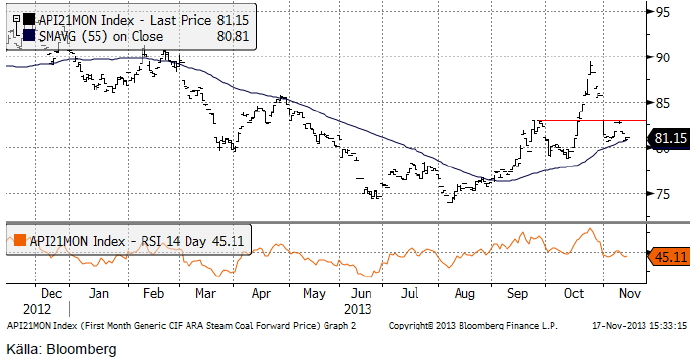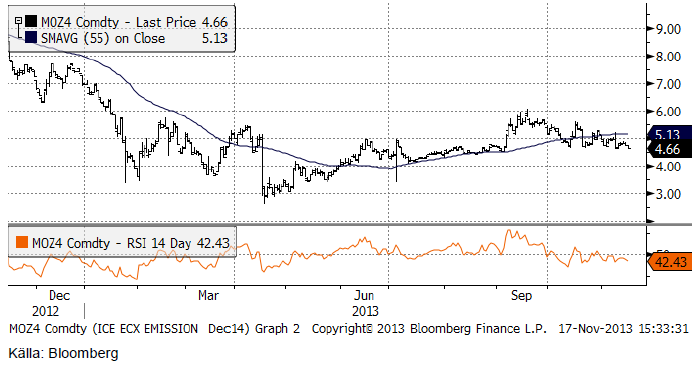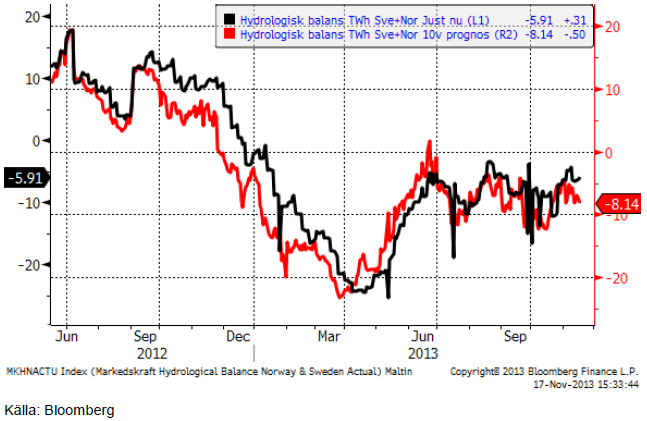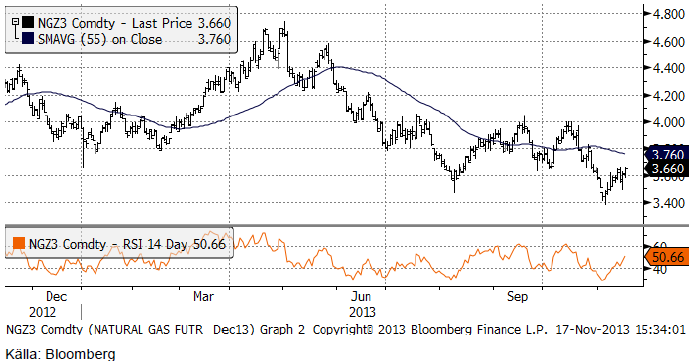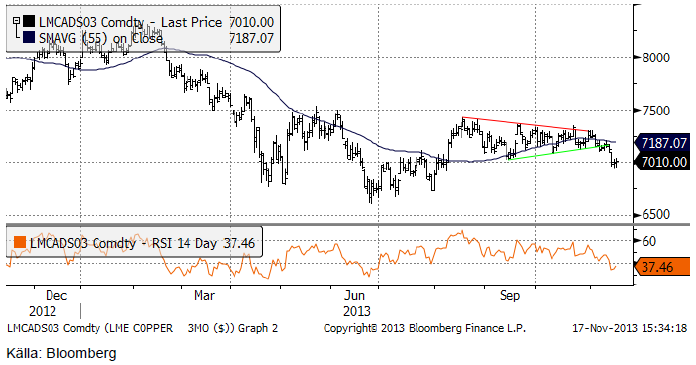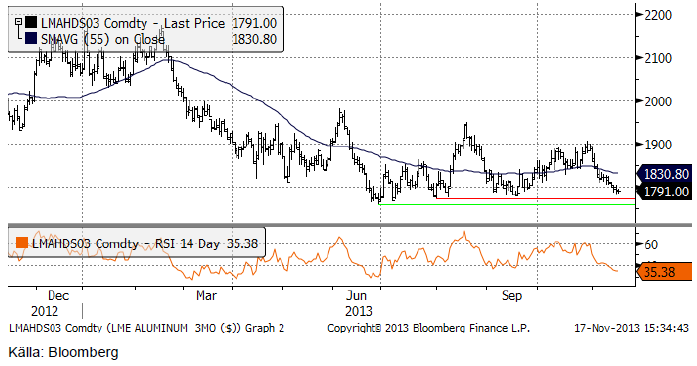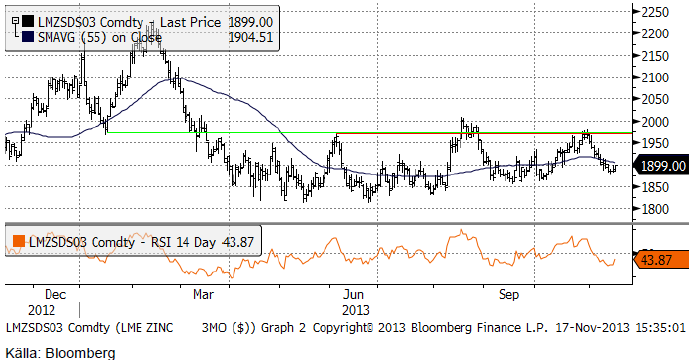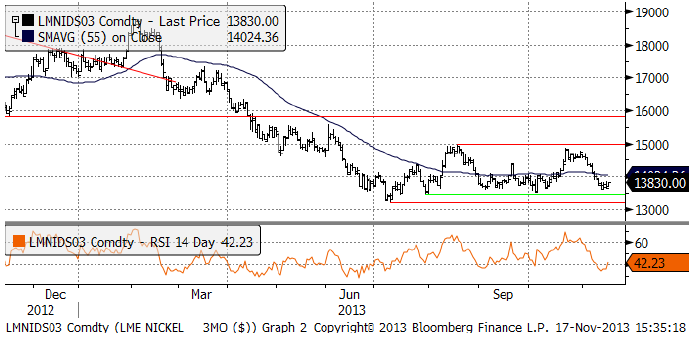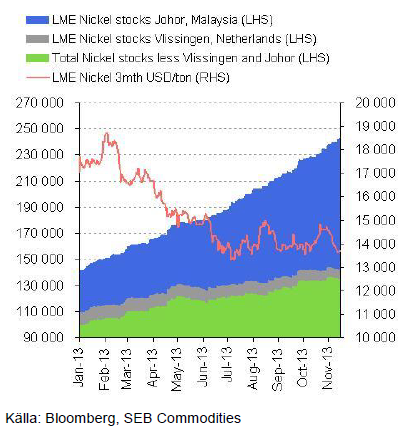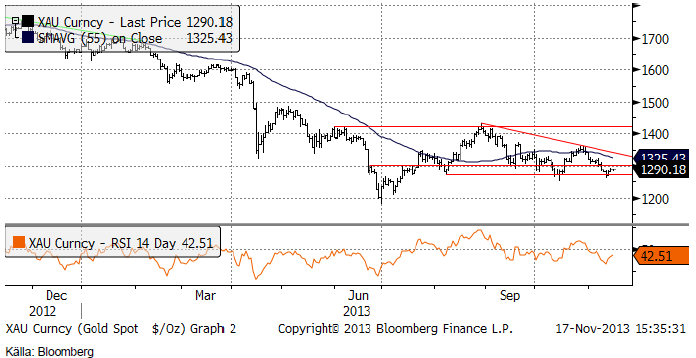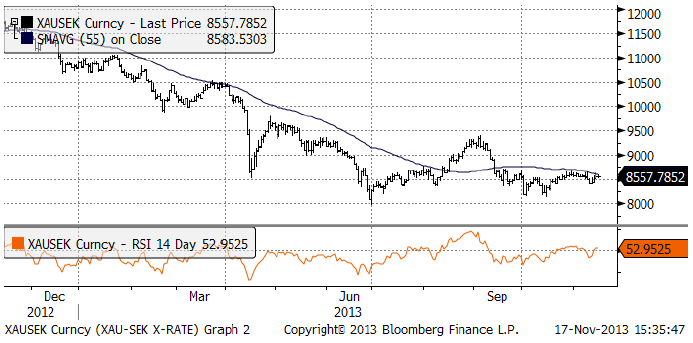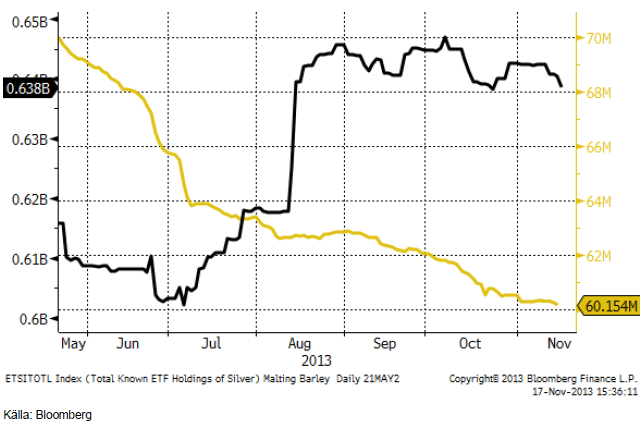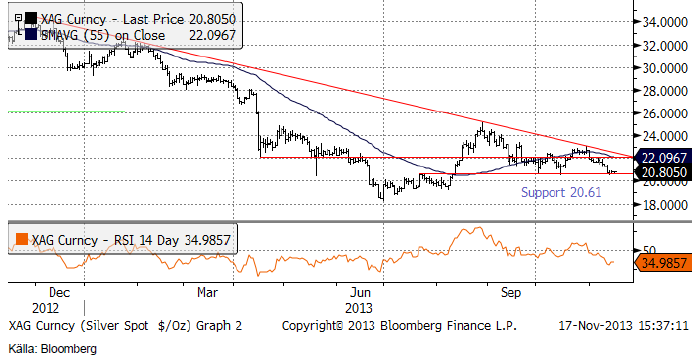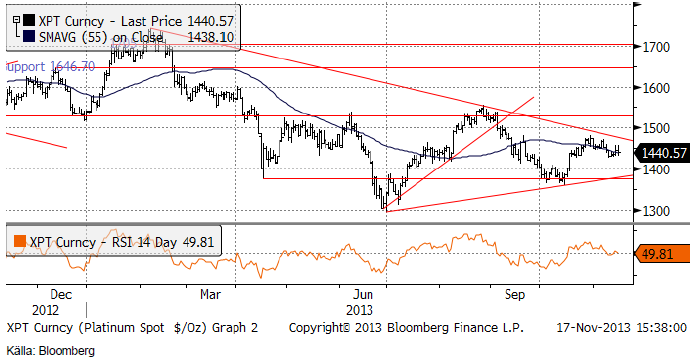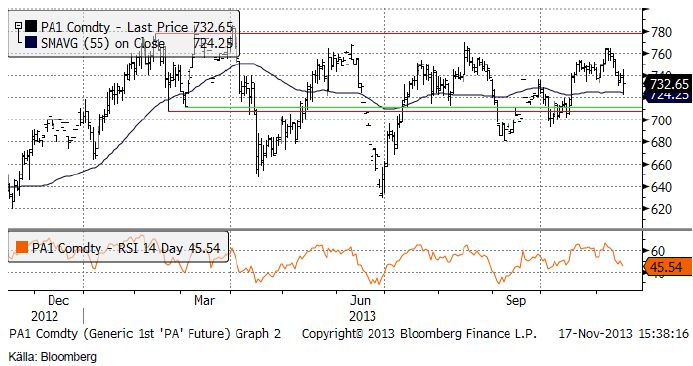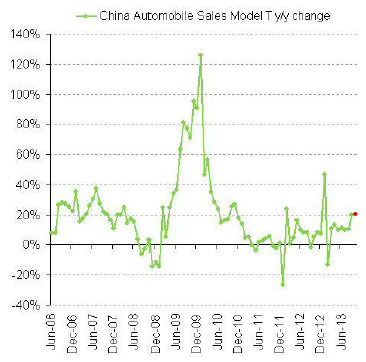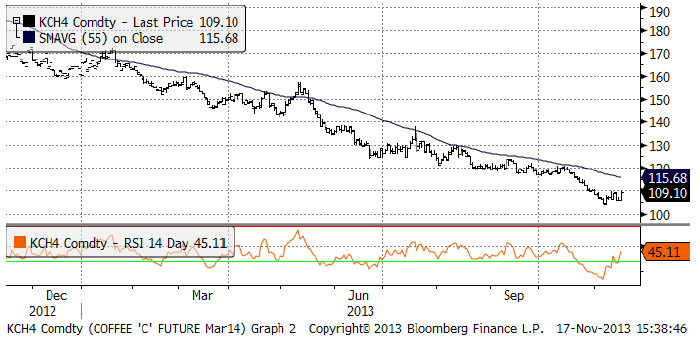Analys
SEB – Råvarukommentarer, 18 november 2013

Rekommendationer
*) Avkastningen anges för 1:1 certifikaten där både BULL och 1:1 certifikat är angivna.
Inledning
Energi handlades upp i förra veckan. OLJA S och EL S steg båda med 4%. Basmetallerna inledde veckan med att fortsätta nedåt, men vände upp mot slutet av veckan. Jordbruksprodukterna handlades allmänt sett något svagt under lugn handel. Det kommer inte att komma så mycket ny information om spannmål och oljeväxter förrän i januari och det finns lite information just nu att handla på.
Ädelmetallerna, som prismässigt inte rosat marknaden alls i år, fick tillbaka lite glans i veckan.
Politiska uttalanden efter det tredje kinesiska politiska plenarmötet (under den 18:e kinesiska folkkongressen) var från början en stor besvikelse för marknaden, som omedelbart fick kinesiska aktier och industrimetaller på fall. Marknaden hade hoppats och förväntat starkare signaler om reformer (liberalisering). Politiska uttalanden från sådana plenarsammanträden, är dock alltid mycket generella och tydligare signaler kan komma under de närmaste veckorna. Marknaderna återhämtade återhämtade sig.
Den tillträdande nya chefen för USA:s centralbank, Janet Yellen sade i veckan: ”Jag anser att det är viktigt att vi gör vad vi kan för att främja en mycket stark återhämtning” Hon placerade sig starkt bakom Bernankes penningpolitik med kvantitativa lättnader, och kommer att fortsätta dessa. Billiga pengar kommer alltså att strömma in i Kina och andra tillväxtmarknader. Detta gav globala aktiemarknader understöd de senaste dagarna. Det har också resulterat i att likvideringen av placeringar i guld har stannat av.
Råolja – Brent
Oljepriset fortsatte att återhämta förlorad mark i veckan som gick. EPA (i USA) meddelade i fredags att inblandningen av biobränslen i amerikanska drivmedel ska sänkas. Det var en förlust för den amerikanska jordbrukslobbyn och en vinst för petroleumindustrin. Prisuppgången i USA är nästan uppe vid det tekniska motståndet 110 dollar och vi tycker att man ska avvakta med köp just nu, även om vi generellt sett tycker att man bör vara köpt OLJA S i en diversifierad sparportfölj.
I onsdagens DOE-rapport steg råoljelagren för åttonde veckan på raken. Lagernivåerna ligger nu återigen på rekordnivåer för den här tiden på året, högre än förra året.
Lagerökningen i USA har hänger dock ihop med en något högre import än de senaste veckorna, som vi ser i diagrammet nedan.
Vi tycker att priset är något ”högt” i dag, och även om vi som sagt tycker att OLJA S erbjuder bra avkastning via rabatten på oljeterminerna, tror vi det är bättre att vänta med köp.
Elektricitet
Elpriset, det första kvartalets kontrakt, gick upp till motståndet i diagrammet nedan, vid 42.35 euro och föll sedan tillbaka för att stänga på 41.60 på veckan. Veckans prisuppgång i el och en starkare euro mot kronan ledde till att EL S steg med 4% och BULL EL X4 S med 14%. Om fredagens nedgång fortsätter i veckan, är det troligt att rekylen nedåt åtminstone går till 41 euro, där det finns ett visst stöd.
Nedan ser vi prisdiagrammet för det första kvartalet 2014:s kontrakt, uppdaterat till i fredags.
Nedan ser vi priset på energikol, den närmaste månadens leveranstermin. Priset slutade veckan med att falla ner till 55-dagars glidande medelvärde igen. Prisuppgången lyckades inte ta priset över 83 dollar, som nu är ett motstånd för vidare uppgång.
Prisutvecklingen på utsläppsrätter har blivit allt lugnare. Vi tror att det är ett temporärt lugn. En avtagande volatilitet på svagt sjunkande kurser, kan plötsligt vändas i en snabb uppgångsfas.
Hydrologisk balans ser vi nedan. Vi ser särskilt att 10-veckorsprognosen föll i veckan och indikerar nu ett hydrologiskt underskott på 8 TWh.
Vi rekommenderar köp av EL S eller BULL EL X4 S, men tycker man kan avvakta någon dag in i veckan ifall marknaden öppnar ner på måndag.
Naturgas
Naturgaspriset som för två veckor sedan fann stöd på 3.40 och vände upp till 3.60, har efter en hastig rekyl fortsatt uppåt. Trenden är dock nedåtriktad och man de som väntar på ett tillfälle att köpa BEAR kan snart få det.
Metaller
Metallerna gynnades allmänt av Yellens besked om att fortsätta Bernankes inslagna linje med kvantitativa lättnader och en expansiv penningpolitik.
Koppar
Kopparpriset föll hela vägen ner till 7000 dollar per ton, där marknaden har gott stöd. I fredagskvällens handel på COMEX i New York kom köpare in och handlade upp marknaden.
Vi tycker att prisfallet har gett en möjlighet att komma in på den långa sidan till bra pris och rekommenderar köp av KOPPAR S.
Aluminium
Aluminium, som är den basmetall vi och de flesta bedömare är mest skeptiska till som placering, har den senaste månaden handlats ner till de lägsta nivåerna de senaste åren, sommarens bottennivåer. Med tanke på hur väl etablerad den bottennivån är, tror vi inte att den kommer att brytas den här gången heller. Vi tror att priset kommer att vända upp från den här låga nivån, och kanske gå till 1850 eller till 1900 dollar per ton. Därför gör vi en kortsiktig rekommendation att köpa ALUMINIUM S.
Zink
Det finns inte så mycket att rapportera om zink den här veckan. Priset fortsatte förra veckans rekyl nedåt i början av veckan, men köpare kom sedan in och gav stöd. Den försiktiga uppåtgående trenden är inte bruten och vi tycker att man kan passa på att försiktigt köpa mer ZINK S.
Nickel
Vår grundsyn är att man ska försöka köpa nickel, i synnerhet om priset kommer ner mot 13,500 dollar per ton. Som vi ser i prisdiagrammet nedan, är priset nere vid den bottennivå som började etableras under juli och vi tror att det är ett bra köptillfälle nu.
LME-lagren av nickel ökade med 4.7 kt till 245 kt senaste 7 dagarna med en liten nedgång i Nederländerna och ytterligare lagerbyggnad i Malaysia. Contangot har ökat längre ut på terminskurvan. När lagren ökar, skapar det kö för att få ut nickel från lagren längre fram. Nedanför ser vi en bild på LME-lagren och priset på 3-månaders terminskontrakt.
Metal Bulletin Research förutspår att lagren av nickel kommer att fortsätta öka både under 2014 och 2015. Det har inte kommit några nyheter om stängningar av nickelgruvor. Många rubriker om Talvivaara, som måste omstrukturera skulden och reserverna har sjunkit 66 %. Aktieägarna har inte varit villiga att skjuta till mer pengar. Tyfonen som drabbat sydöstra Asien, verkar inte ha förstört nickel produktionen i Filippinerna. Sumitomo meddelade att deras smältverk i Filippinerna producerat sin första nickel och exporterat metallen till Japan.
Vår grundsyn att man bör försöka köpa nickel och rekommenderar köp av NICKEL S. Priset (cash och 3 månaders termin, som vi alltid avser), går att följa på www.basemetals.com
Guld
Guldpriset (i dollar) gick i veckan ner och testade det tekniska stödet och steg mot slutet av veckan till 1290 dollar. Trenden är nedåtriktad, men volatiliteten har sjunkit, med allt mindre kursrörelser. Det är ett mönster som ibland förebådar en trendvändning uppåt, men det återstår att se.
I termer av kronor, har priset hållit sig stabilt, med endast marginella prisrörelser under veckan. Vi ser kursdiagrammet på priset i kronor för ett troy uns nedan. Notera att vi inte har någon teknisk köpsignal, men vi har ett tekniskt stöd vid 8000 kr. Trenden är fortfarande nedåtriktad.
I diagrammet nedan ser vi antalet uns som innehas av börshandlade fonder det senaste halvåret. Den gula kurvan avser guld och den svarta silver. Utflödet ur guldfonder har minskat i november, medan utflödet ur silverfonder ökat.
World Gold Council rapporterade i veckan att efterfrågan på guld under det tredje kvartalet minskat med 21% sedan förra året till 868.5 ton. Det är framförallt utflöden ur börshandlade fonder som ligger bakom. Investeringsefterfrågan har minskat med 56% sedan förra året. Efterfrågan på fysiskt guld har ökat något till 304 ton, medan börshandlade produkter haft ett utflöde på 119 ton. Utbudet av guld har också minskat, trots att gruvproduktionen ökat något. Det är skrotningen (av smycken) som står för minskningen.
I dessa siffror ligger också en viss nyckel till hur en uppgång skulle kunna börja. Fysiskt investeringsguld säljs sällan, eftersom det inte är lika likvitt som börshandlade produkter. Skulle investeringsflödet i börshandlade produkter vända, t ex motiverat av låga eller ännu lägre räntor och en fortsatt expansiv penningpolitik, kan det ge marknaden stöd.
Trots att det finns vissa positiva tecken, tycker vi dock att det är för tidigt och för spekulativt att köpa guld just nu och föredrar att vänta till dess det skett ett trendbrott.
Silver
Nedan ser vi kursdiagrammet för silver i dollar per troy ounce. Priset stängde i fredags på 20.8 dollar per uns, strax över det viktiga tekniska stödet på 20.61. Om det stödet bryts, kan priset gå ner mot 18 dollar i första hand. Om priset å andra sidan går över 22 dollar bryts den långsiktiga nedåtgående trenden. Marknaden står och väger just nu.
Vi fortsätter att vara neutrala guld och silver.
Platina & Palladium
Platinapriset ligger fortfarande under motståndet och kan lika gärna gå ner som upp. Men de lite mer positiva tongångarna från den tillträdande chefen för USA:s centralbank om en fortsatt mjuk penningpolitik, tror vi att det finns mer uppsida. Dessutom är arbetsmarknadskonflikten i Sydafrika snarare på väg att eskalera än att gå mot en snar lösning.
Enligt Johnson Matthey kommer efterfrågan på platina att överstiga utbudet av med den största skillnaden sedan år 1999. Sammanlagt blir underskottet 605 000 ozt, vilket är en ökning av underskottet med 78 % sedan förra året. Johnson Matthey förväntar sig en ingen lösning på problemen i Sydafrika. Impala Platinum har erbjudit en löneökning till sina anställda på 0.5%. Amplats mining skjöt med gummikulor för att skingra demonstranter vid gruvan i veckan. AMCU, den andra fackföreningen som ännu inte gått i strejk, har fått tillstånd av myndigheterna att gå i strejk om det inte sker några framsteg i löneförhandlingarna. Fackföreningen kommer att ha möten de närmaste veckorna för att besluta hur de ska göra. AMCU är den största fackföreningen vid det största platinaföretaget, Anglo American Platinum Ltd.
PwC, den välkända revisionsfirman varnade i veckan att Sydafrikas gruvindustri kan falla i ruiner på grund av höga löner och lagstadgade kostnader.
Strejken vid Northam Platinums gruva i Sydafrika fortsätter. Det är svårt att säga hur mycket platina som fallit bort från utbudet.
Priset på palladium har backat den senaste veckan, efter att ha kommit för högt upp i det prisintervall som varit rådande det senaste året. Det verkar finnas gott om material på pris över 760 dollar per uns.
Enligt Johnson Matthey blir det ett underskott på 740 000 uns palladium i år, men det är 36 % lägre än underskottet var 2012.
Antalet sålda bilar i Kina i september och oktober låg på en årlig försäljningstakt på 23 miljoner bilar, vilket var mer än väntat. Den årliga ökningstakten är 20 %. Detta har dock ändå inte hindrat att priset på palladium sjunkit med 3% den senaste veckan.
Situationen i Sydafrika tycker vi är så alarmerande att vi väljer att gå över till köprekommendation igen. Däremot behåller vi neutral på palladium.
Kaffe
Kaffepriset handlade hela veckan över den tidigare bottennivån strax över 100 cent och stängde veckan på 109 cent. 110 cent har rekylen dock ännu inte lyckats ta sig över.
På en konferens i lördags (16 nov) i Costa Rica, sade BNP Paribas kaffeanalytiker att produktionsöverskottet i år 2013/14, som började den 1 oktober sjunker till 3 miljoner säckar (à 60 Kg) från 4 miljoner säckar under 2012/13. Nästan hela överskottet utgörs av arabica. Konsumtionen av den billigare och enklare och mer lättodlade robustan ökar i tillväxtländerna så att den relativt stora produktionsökningen framförallt i Vietnam sväljs.
I fredags sänkte dock USDA estimatet för Brasiliens skörd av kaffe (huvudsakligen arabica) från 53.7 miljoner säckar till 53.1 miljoner för 2013/14, vilket är 3 miljoner säckar mindre än under 2012/13. Det står i rapporten på USDA:s hemsida att kvaliteten är sämre än förra året.
Kostnaderna väntas stiga från en nivå 2012/13 på 122 cent per pund till 134 cent per pund. Det innebär att priset ligger under en nivå där 50% av kaffeproducenterna i Brasilien gör förlust. Det är naturligtvis en ohållbart låg prisnivå. Den som vill läsa rapporten kan göra det här.
Vi behåller tills vidare neutral rekommendation, tills vi ser tecken på ett trendbrott.
För analyser på övriga jordbruksråvaror se SEB Jordbruksprodukter.
[box]SEB Veckobrev Veckans råvarukommentar är producerat av SEB Merchant Banking och publiceras i samarbete och med tillstånd på Råvarumarknaden.se[/box]
Disclaimer
The information in this document has been compiled by SEB Merchant Banking, a division within Skandinaviska Enskilda Banken AB (publ) (“SEB”).
Opinions contained in this report represent the bank’s present opinion only and are subject to change without notice. All information contained in this report has been compiled in good faith from sources believed to be reliable. However, no representation or warranty, expressed or implied, is made with respect to the completeness or accuracy of its contents and the information is not to be relied upon as authoritative. Anyone considering taking actions based upon the content of this document is urged to base his or her investment decisions upon such investigations as he or she deems necessary. This document is being provided as information only, and no specific actions are being solicited as a result of it; to the extent permitted by law, no liability whatsoever is accepted for any direct or consequential loss arising from use of this document or its contents.
About SEB
SEB is a public company incorporated in Stockholm, Sweden, with limited liability. It is a participant at major Nordic and other European Regulated Markets and Multilateral Trading Facilities (as well as some non-European equivalent markets) for trading in financial instruments, such as markets operated by NASDAQ OMX, NYSE Euronext, London Stock Exchange, Deutsche Börse, Swiss Exchanges, Turquoise and Chi-X. SEB is authorized and regulated by Finansinspektionen in Sweden; it is authorized and subject to limited regulation by the Financial Services Authority for the conduct of designated investment business in the UK, and is subject to the provisions of relevant regulators in all other jurisdictions where SEB conducts operations. SEB Merchant Banking. All rights reserved.
Analys
Tightening fundamentals – bullish inventories from DOE

The latest weekly report from the US DOE showed a substantial drawdown across key petroleum categories, adding more upside potential to the fundamental picture.

Commercial crude inventories (excl. SPR) fell by 5.8 million barrels, bringing total inventories down to 415.1 million barrels. Now sitting 11% below the five-year seasonal norm and placed in the lowest 2015-2022 range (see picture below).
Product inventories also tightened further last week. Gasoline inventories declined by 2.1 million barrels, with reductions seen in both finished gasoline and blending components. Current gasoline levels are about 3% below the five-year average for this time of year.
Among products, the most notable move came in diesel, where inventories dropped by almost 4.1 million barrels, deepening the deficit to around 20% below seasonal norms – continuing to underscore the persistent supply tightness in diesel markets.
The only area of inventory growth was in propane/propylene, which posted a significant 5.1-million-barrel build and now stands 9% above the five-year average.
Total commercial petroleum inventories (crude plus refined products) declined by 4.2 million barrels on the week, reinforcing the overall tightening of US crude and products.


Analys
Bombs to ”ceasefire” in hours – Brent below $70

A classic case of “buy the rumor, sell the news” played out in oil markets, as Brent crude has dropped sharply – down nearly USD 10 per barrel since yesterday evening – following Iran’s retaliatory strike on a U.S. air base in Qatar. The immediate reaction was: “That was it?” The strike followed a carefully calibrated, non-escalatory playbook, avoiding direct threats to energy infrastructure or disruption of shipping through the Strait of Hormuz – thus calming worst-case fears.

After Monday morning’s sharp spike to USD 81.4 per barrel, triggered by the U.S. bombing of Iranian nuclear facilities, oil prices drifted sideways in anticipation of a potential Iranian response. That response came with advance warning and caused limited physical damage. Early this morning, both the U.S. President and Iranian state media announced a ceasefire, effectively placing a lid on the immediate conflict risk – at least for now.
As a result, Brent crude has now fallen by a total of USD 12 from Monday’s peak, currently trading around USD 69 per barrel.
Looking beyond geopolitics, the market will now shift its focus to the upcoming OPEC+ meeting in early July. Saudi Arabia’s decision to increase output earlier this year – despite falling prices – has drawn renewed attention considering recent developments. Some suggest this was a response to U.S. pressure to offset potential Iranian supply losses.
However, consensus is that the move was driven more by internal OPEC+ dynamics. After years of curbing production to support prices, Riyadh had grown frustrated with quota-busting by several members (notably Kazakhstan). With Saudi Arabia cutting up to 2 million barrels per day – roughly 2% of global supply – returns were diminishing, and the risk of losing market share was rising. The production increase is widely seen as an effort to reassert leadership and restore discipline within the group.
That said, the FT recently stated that, the Saudis remain wary of past missteps. In 2018, Riyadh ramped up output at Trump’s request ahead of Iran sanctions, only to see prices collapse when the U.S. granted broad waivers – triggering oversupply. Officials have reportedly made it clear they don’t intend to repeat that mistake.
The recent visit by President Trump to Saudi Arabia, which included agreements on AI, defense, and nuclear cooperation, suggests a broader strategic alignment. This has fueled speculation about a quiet “pump-for-politics” deal behind recent production moves.
Looking ahead, oil prices have now retraced the entire rally sparked by the June 13 Israel–Iran escalation. This retreat provides more political and policy space for both the U.S. and Saudi Arabia. Specifically, it makes it easier for Riyadh to scale back its three recent production hikes of 411,000 barrels each, potentially returning to more moderate increases of 137,000 barrels for August and September.
In short: with no major loss of Iranian supply to the market, OPEC+ – led by Saudi Arabia – no longer needs to compensate for a disruption that hasn’t materialized, especially not to please the U.S. at the cost of its own market strategy. As the Saudis themselves have signaled, they are unlikely to repeat previous mistakes.
Conclusion: With Brent now in the high USD 60s, buying oil looks fundamentally justified. The geopolitical premium has deflated, but tensions between Israel and Iran remain unresolved – and the risk of missteps and renewed escalation still lingers. In fact, even this morning, reports have emerged of renewed missile fire despite the declared “truce.” The path forward may be calmer – but it is far from stable.
Analys
A muted price reaction. Market looks relaxed, but it is still on edge waiting for what Iran will do

Brent crossed the 80-line this morning but quickly fell back assigning limited probability for Iran choosing to close the Strait of Hormuz. Brent traded in a range of USD 70.56 – 79.04/b last week as the market fluctuated between ”Iran wants a deal” and ”US is about to attack Iran”. At the end of the week though, Donald Trump managed to convince markets (and probably also Iran) that he would make a decision within two weeks. I.e. no imminent attack. Previously when when he has talked about ”making a decision within two weeks” he has often ended up doing nothing in the end. The oil market relaxed as a result and the week ended at USD 77.01/b which is just USD 6/b above the year to date average of USD 71/b.

Brent jumped to USD 81.4/b this morning, the highest since mid-January, but then quickly fell back to a current price of USD 78.2/b which is only up 1.5% versus the close on Friday. As such the market is pricing a fairly low probability that Iran will actually close the Strait of Hormuz. Probably because it will hurt Iranian oil exports as well as the global oil market.
It was however all smoke and mirrors. Deception. The US attacked Iran on Saturday. The attack involved 125 warplanes, submarines and surface warships and 14 bunker buster bombs were dropped on Iranian nuclear sites including Fordow, Natanz and Isfahan. In response the Iranian Parliament voted in support of closing the Strait of Hormuz where some 17 mb of crude and products is transported to the global market every day plus significant volumes of LNG. This is however merely an advise to the Supreme leader Ayatollah Ali Khamenei and the Supreme National Security Council which sits with the final and actual decision.
No supply of oil is lost yet. It is about the risk of Iran closing the Strait of Hormuz or not. So far not a single drop of oil supply has been lost to the global market. The price at the moment is all about the assessed risk of loss of supply. Will Iran choose to choke of the Strait of Hormuz or not? That is the big question. It would be painful for US consumers, for Donald Trump’s voter base, for the global economy but also for Iran and its population which relies on oil exports and income from selling oil out of that Strait as well. As such it is not a no-brainer choice for Iran to close the Strait for oil exports. And looking at the il price this morning it is clear that the oil market doesn’t assign a very high probability of it happening. It is however probably well within the capability of Iran to close the Strait off with rockets, mines, air-drones and possibly sea-drones. Just look at how Ukraine has been able to control and damage the Russian Black Sea fleet.
What to do about the highly enriched uranium which has gone missing? While the US and Israel can celebrate their destruction of Iranian nuclear facilities they are also scratching their heads over what to do with the lost Iranian nuclear material. Iran had 408 kg of highly enriched uranium (IAEA). Almost weapons grade. Enough for some 10 nuclear warheads. It seems to have been transported out of Fordow before the attack this weekend.
The market is still on edge. USD 80-something/b seems sensible while we wait. The oil market reaction to this weekend’s events is very muted so far. The market is still on edge awaiting what Iran will do. Because Iran will do something. But what and when? An oil price of 80-something seems like a sensible level until something do happen.
-

 Nyheter4 veckor sedan
Nyheter4 veckor sedanStor uppsida i Lappland Guldprospekterings aktie enligt analys
-

 Nyheter4 veckor sedan
Nyheter4 veckor sedanSilverpriset släpar efter guldets utveckling, har mer uppsida
-

 Nyheter3 veckor sedan
Nyheter3 veckor sedanUppgången i oljepriset planade ut under helgen
-

 Nyheter2 veckor sedan
Nyheter2 veckor sedanMahvie Minerals växlar spår – satsar fullt ut på guld
-

 Nyheter3 veckor sedan
Nyheter3 veckor sedanLåga elpriser i sommar – men mellersta Sverige får en ökning
-

 Analys3 veckor sedan
Analys3 veckor sedanVery relaxed at USD 75/b. Risk barometer will likely fluctuate to higher levels with Brent into the 80ies or higher coming 2-3 weeks
-

 Nyheter2 veckor sedan
Nyheter2 veckor sedanOljan, guldet och marknadens oroande tystnad
-

 Nyheter2 veckor sedan
Nyheter2 veckor sedanJonas Lindvall är tillbaka med ett nytt oljebolag, Perthro, som ska börsnoteras


